display TOYOTA iQ EV 2013 Owners Manual (in English)
[x] Cancel search | Manufacturer: TOYOTA, Model Year: 2013, Model line: iQ EV, Model: TOYOTA iQ EV 2013Pages: 444, PDF Size: 7.34 MB
Page 2 of 444
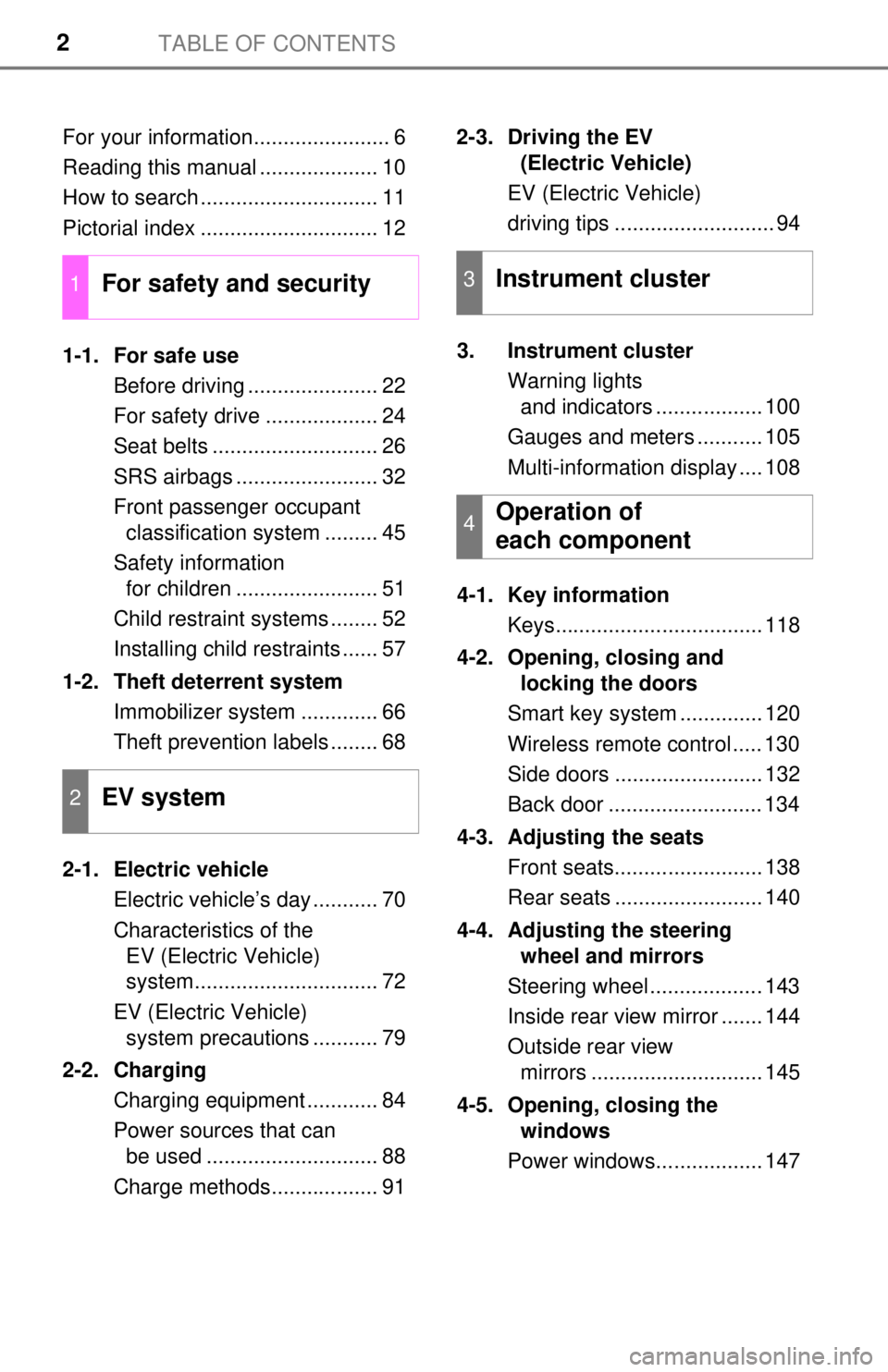
TABLE OF CONTENTS2
For your information....................... 6
Reading this manual .................... 10
How to search .............................. 11
Pictorial index .............................. 12
1-1. For safe useBefore driving ...................... 22
For safety drive ................... 24
Seat belts ............................ 26
SRS airbags ........................ 32
Front passenger occupant classification system ......... 45
Safety information for children ........................ 51
Child restraint systems ........ 52
Installing child restraints ...... 57
1-2. Theft deterrent system Immobilizer system ............. 66
Theft prevention labels ........ 68
2-1. Electric vehicle Electric vehicle’s day ........... 70
Characteristics of the EV (Electric Vehicle)
system............................... 72
EV (Electric Vehicle) system precautions ........... 79
2-2. Charging Charging equipment ............ 84
Power sources that can be used ............................. 88
Charge methods.................. 91 2-3. Driving the EV
(Electric Vehicle)
EV (Electric Vehicle)
driving tips ........................... 94
3. Instrument cluster Warning lights and indicators .................. 100
Gauges and meters ........... 105
Multi-information display .... 108
4-1. Key information Keys................................... 118
4-2. Opening, closing and locking the doors
Smart key system .............. 120
Wireless remote control ..... 130
Side doors ......................... 132
Back door .......................... 134
4-3. Adjusting the seats Front seats......................... 138
Rear seats ......................... 140
4-4. Adjusting the steering wheel and mirrors
Steering wheel ................... 143
Inside rear view mirror ....... 144
Outside rear view mirrors ............................. 145
4-5. Opening, closing the windows
Power windows.................. 147
1For safety and security
2EV system
3Instrument cluster
4Operation of
each component
Page 3 of 444
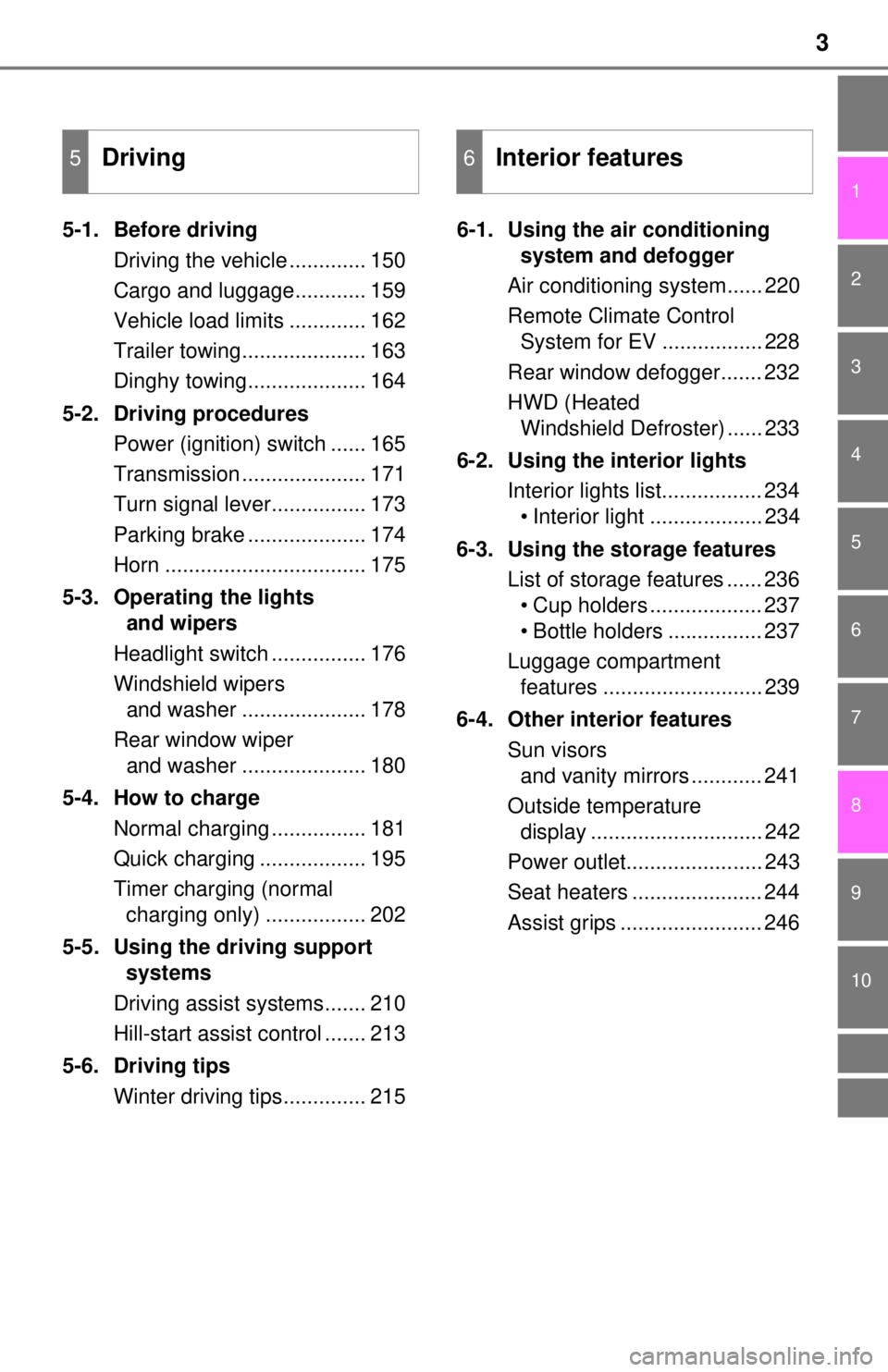
3
9 8
7
6
5
4
3
10
1
2
5-1. Before drivingDriving the vehicle ............. 150
Cargo and luggage............ 159
Vehicle load limits ............. 162
Trailer towing..................... 163
Dinghy towing.................... 164
5-2. Driving procedures Power (ignition) switch ...... 165
Transmission ..................... 171
Turn signal lever................ 173
Parking brake .................... 174
Horn .................................. 175
5-3. Operating the lights and wipers
Headlight switch ................ 176
Windshield wipers and washer ..................... 178
Rear window wiper and washer ..................... 180
5-4. How to charge Normal charging ................ 181
Quick charging .................. 195
Timer charging (normal charging only) ................. 202
5-5. Using the driving support systems
Driving assist systems....... 210
Hill-start assist control ....... 213
5-6. Driving tips Winter driving tips.............. 215 6-1. Using the air conditioning
system and defogger
Air conditioning system...... 220
Remote Climate Control System for EV ................. 228
Rear window defogger....... 232
HWD (Heated Windshield Defroster) ...... 233
6-2. Using the interior lights Interior lights list................. 234• Interior light ................... 234
6-3. Using the storage features List of storage features ...... 236• Cup holders ................... 237
• Bottle holders ................ 237
Luggage compartment features ........................... 239
6-4. Other interior features Sun visors and vanity mirrors ............ 241
Outside temperature display ............................. 242
Power outlet....................... 243
Seat heaters ...................... 244
Assist grips ........................ 246
5Driving6Interior features
Page 4 of 444

TABLE OF CONTENTS4
7-1. Maintenance and careCleaning and protecting the vehicle exterior .......... 248
Cleaning and protecting the vehicle interior ........... 251
7-2. Maintenance Maintenance requirements ................... 254
General maintenance ........ 256
7-3. Do-it-yourself maintenance Do-it-yourself service precautions ..................... 260
Inspecting the charging cable ............................... 262
Hood.................................. 264
Positioning a floor jack ...... 266
Replacing the tire .............. 269
Motor compartment ........... 277
Tires .................................. 285
Tire inflation pressure........ 292
Wheels .............................. 295
Air conditioning filter .......... 297
Electronic key battery ........ 299
Checking and replacing fuses ............................... 301
Light bulbs ......................... 311 8-1. Essential information
Emergency flashers ........... 328
If your vehicle has to be stopped in an
emergency....................... 329
8-2. Steps to take in an emergency
If your vehicle needs to be towed ...................... 330
If you think something is wrong ......... 334
If a warning light turns on or a warning buzzer
sounds ............................. 335
If a warning message is displayed...................... 344
If you have a flat tire .......... 359
If the EV system will not start ................................. 375
If charging cannot be done ........................... 377
If the shift lever cannot be shifted from P ............. 383
If the electronic key does not operate properly ........ 384
If the 12-volt battery is discharged ................... 386
If your vehicle overheats.... 390
If the vehicle becomes stuck ................................ 393
7Maintenance and care8When trouble arises
Page 15 of 444
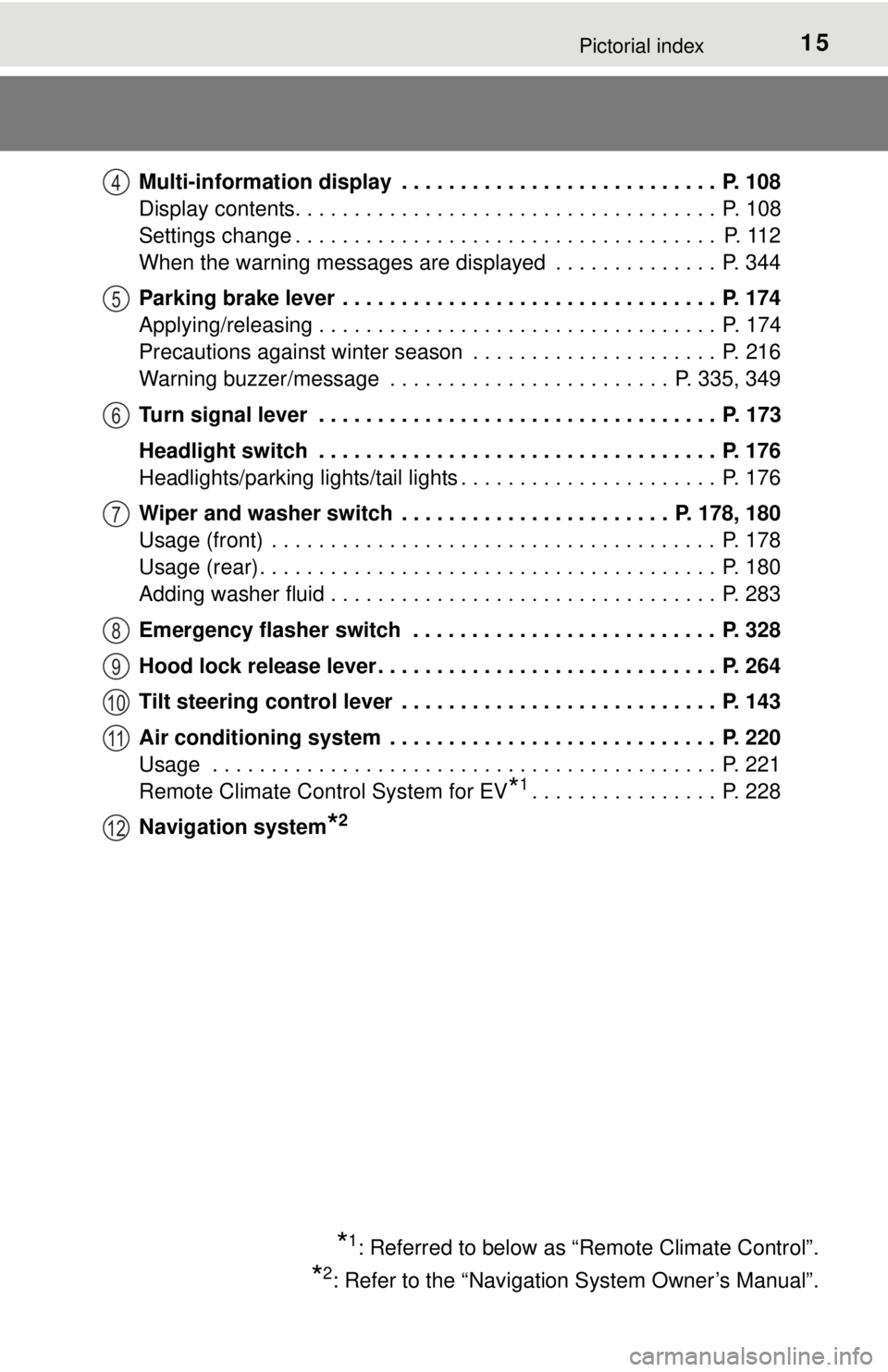
15Pictorial index
Multi-information display . . . . . . . . . . . . . . . . . . . . . . . . . . . P. 108
Display contents. . . . . . . . . . . . . . . . . . . . . . . . . . . . . . . . . . . . P. 108
Settings change . . . . . . . . . . . . . . . . . . . . . . . . . . . . . . . . . . . . P. 112
When the warning messages are displayed . . . . . . . . . . . . . . P. 344
Parking brake lever . . . . . . . . . . . . . . . . . . . . . . . . . . . . . . . . P. 174
Applying/releasing . . . . . . . . . . . . . . . . . . . . . . . . . . . . . . . . . . P. 174
Precautions against winter season . . . . . . . . . . . . . . . . . . . . . P. 216
Warning buzzer/message . . . . . . . . . . . . . . . . . . . . . . . . P. 335, 349
Turn signal lever . . . . . . . . . . . . . . . . . . . . . . . . . . . . . . . . . . P. 173
Headlight switch . . . . . . . . . . . . . . . . . . . . . . . . . . . . . . . . . . P. 176
Headlights/parking lights/tail lights . . . . . . . . . . . . . . . . . . . . . . P. 176
Wiper and washer switch . . . . . . . . . . . . . . . . . . . . . . . P. 178, 180
Usage (front) . . . . . . . . . . . . . . . . . . . . . . . . . . . . . . . . . . . . . . P. 178
Usage (rear) . . . . . . . . . . . . . . . . . . . . . . . . . . . . . . . . . . . . . . . P. 180
Adding washer fluid . . . . . . . . . . . . . . . . . . . . . . . . . . . . . . . . . P. 283
Emergency flasher switch . . . . . . . . . . . . . . . . . . . . . . . . . . P. 328
Hood lock release lever. . . . . . . . . . . . . . . . . . . . . . . . . . . . . P. 264
Tilt steering control lever . . . . . . . . . . . . . . . . . . . . . . . . . . . P. 143
Air conditioning system . . . . . . . . . . . . . . . . . . . . . . . . . . . . P. 220
Usage . . . . . . . . . . . . . . . . . . . . . . . . . . . . . . . . . . . . . . . . . . . P. 221
Remote Climate Control System for EV
*1. . . . . . . . . . . . . . . . P. 228
Navigation system
*2
*1: Referred to below as “Remote Climate Control”.
*2: Refer to the “Navigation System Owner’s Manual”.
4
5
6
7
8
9
10
11
12
Page 16 of 444
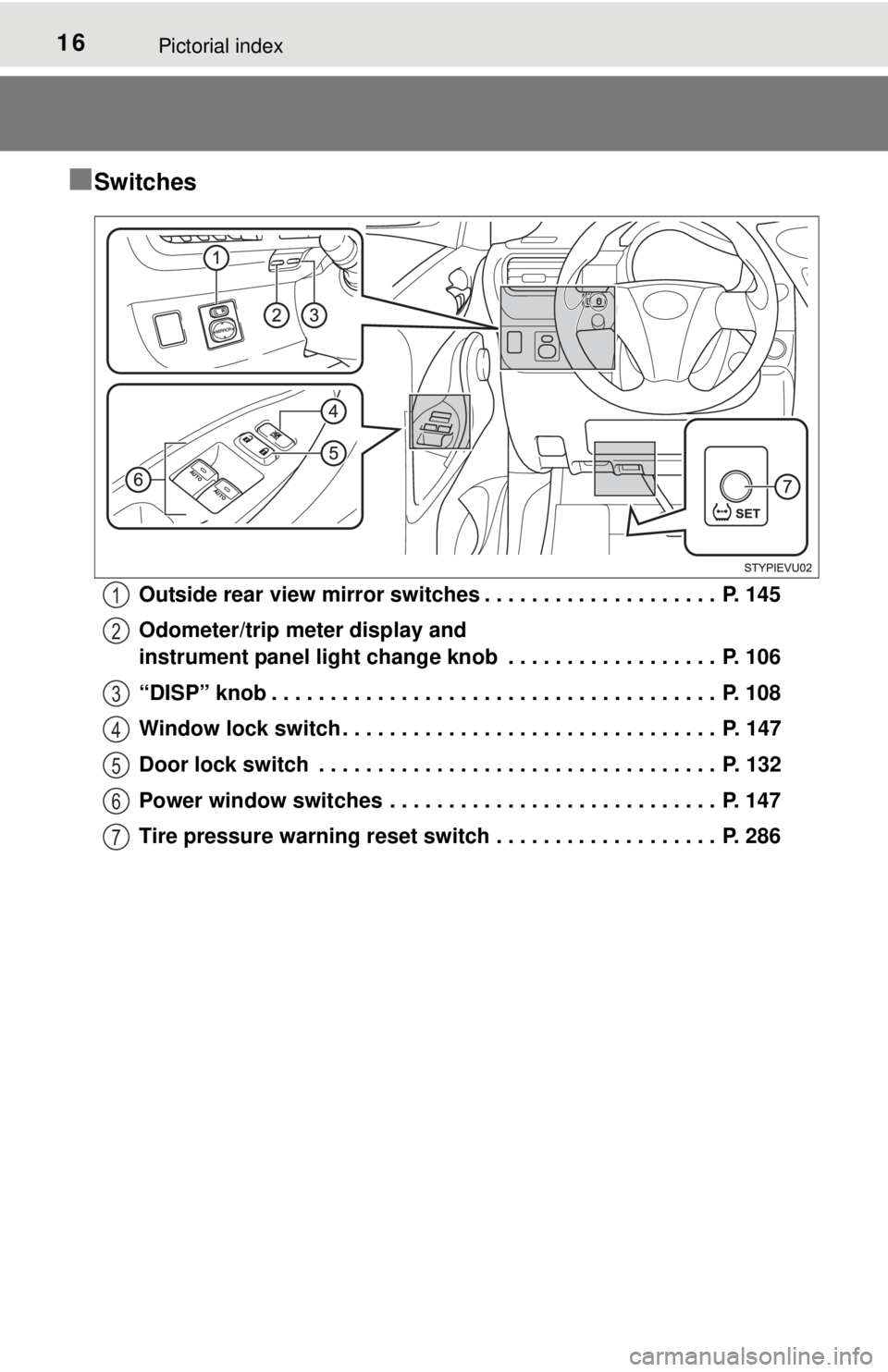
16Pictorial index
■Switches
Outside rear view mirror switches . . . . . . . . . . . . . . . . . . . . P. 145
Odometer/trip meter display and
instrument panel light change knob . . . . . . . . . . . . . . . . . . P. 106
“DISP” knob . . . . . . . . . . . . . . . . . . . . . . . . . . . . . . . . . . . . . . P. 108
Window lock switch . . . . . . . . . . . . . . . . . . . . . . . . . . . . . . . . P. 147
Door lock switch . . . . . . . . . . . . . . . . . . . . . . . . . . . . . . . . . . P. 132
Power window switches . . . . . . . . . . . . . . . . . . . . . . . . . . . . P. 147
Tire pressure warning reset switch . . . . . . . . . . . . . . . . . . . P. 2861
2
3
4
5
6
7
Page 57 of 444
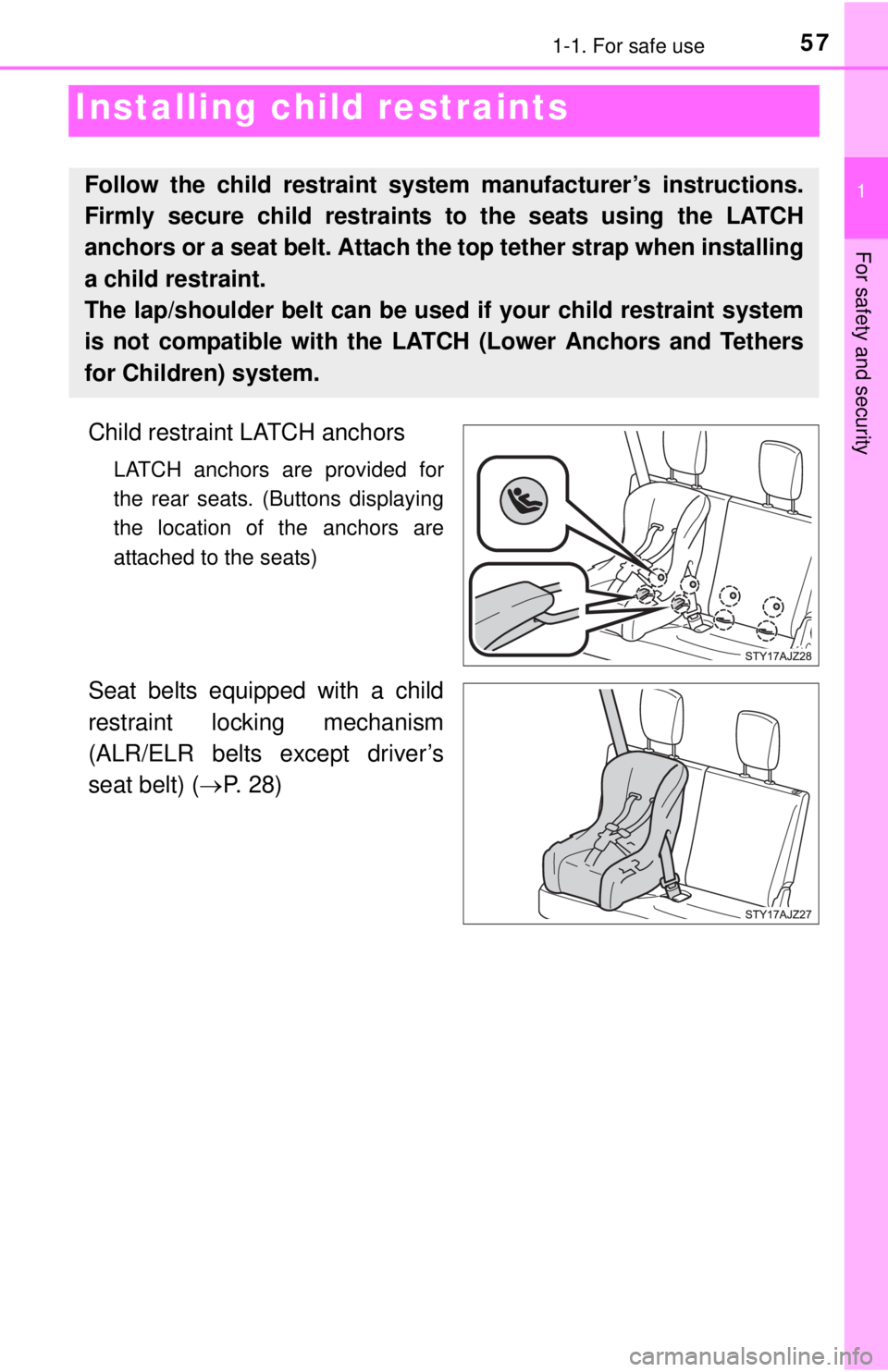
571-1. For safe use
1
For safety and security
Installing child restraints
Child restraint LATCH anchors
LATCH anchors are provided for
the rear seats. (Buttons displaying
the location of the anchors are
attached to the seats)
Seat belts equipped with a child
restraint locking mechanism
(ALR/ELR belts except driver’s
seat belt) (P. 28)
Follow the child restraint system manufacturer’s instructions.
Firmly secure child restraints to the seats using the LATCH
anchors or a seat belt. Attach the top tether strap when installing
a child restraint.
The lap/shoulder belt can be used if your child restraint system
is not compatible with the LATCH (Lower Anchors and Tethers
for Children) system.
Page 74 of 444
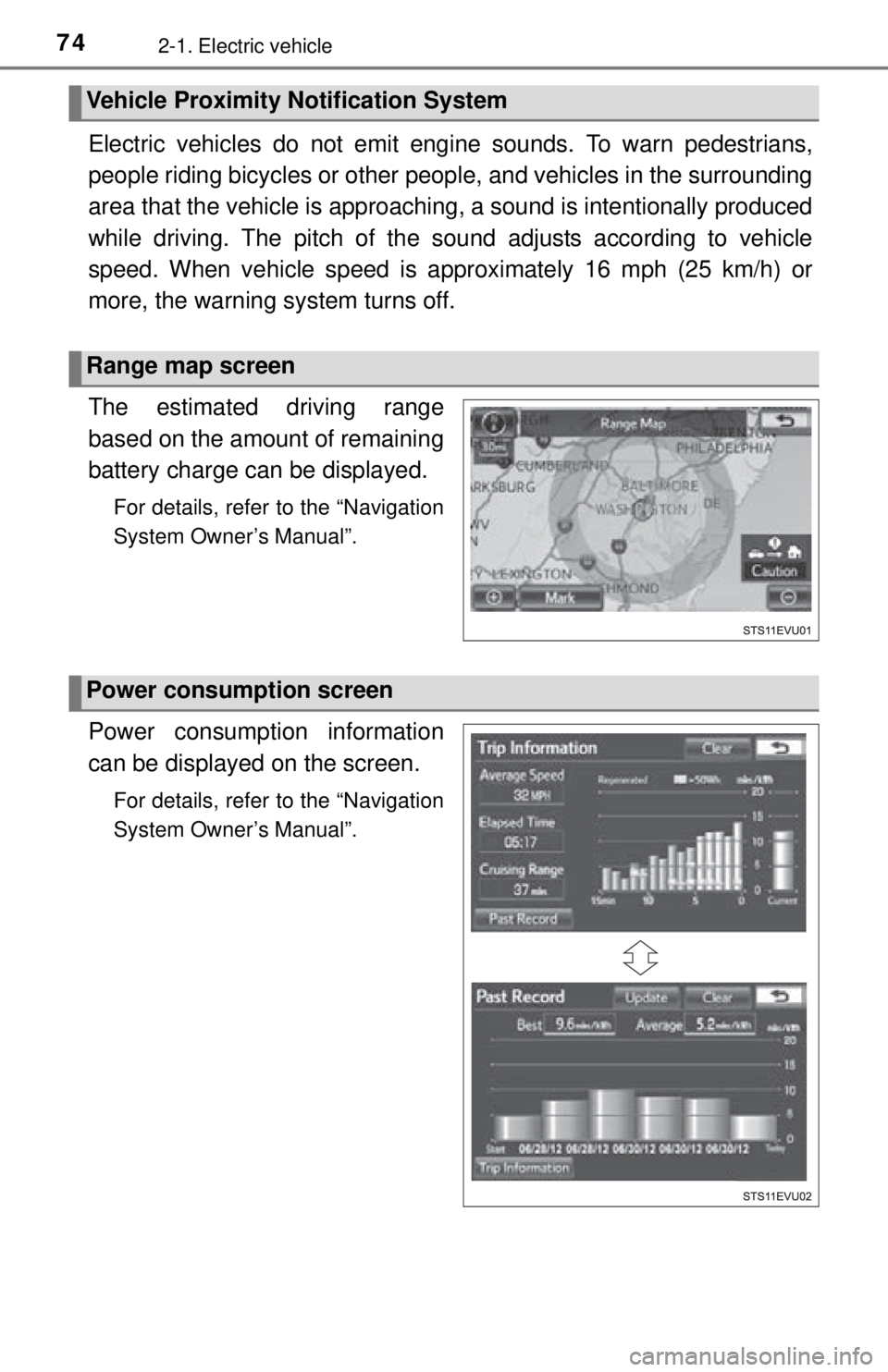
742-1. Electric vehicle
Electric vehicles do not emit engine sounds. To warn pedestrians,
people riding bicycles or other peop le, and vehicles in the surrounding
area that the vehicle is approaching , a sound is intentionally produced
while driving. The pitch of the s ound adjusts according to vehicle
speed. When vehicle speed is approximately 16 mph (25 km/h) or
more, the warning system turns off.
The estimated driving range
based on the amount of remaining
battery charge can be displayed.
For details, refer to the “Navigation
System Owner’s Manual”.
Power consumpti on information
can be displayed on the screen.
For details, refer to the “Navigation
System Owner’s Manual”.
Vehicle Proximity Notification System
Range map screen
Power consumption screen
Page 75 of 444

752-1. Electric vehicle
2
EV system
■Regenerative braking
In the following situations, kinetic energy is converted to electric energy and
deceleration force can be obtained in conjunction with the recharging of the
traction battery.
●The accelerator pedal is released while driving with the shift lever in D, S or
B.
● The brake pedal is depressed while driving with the shift lever in D, S or B.
If “REGENERATIVE BRAKING LIMITED” appears on the multi-information
display, refer to P. 347.
■ 12-volt battery recharging
The 12-volt battery is charged from the traction battery when the EV system
is operated or while the traction battery is being charged.
If the vehicle has not been used for a long time, the 12-volt battery may
become low due to self-discharge. If this occurs, follow the correct proce-
dures. ( P. 386)
■ When not using the vehicle for an extended period of time
P. 191
■ Charging the traction battery
Be sure to maintain the traction battery charge level suitable for your driving
needs.
If the traction battery fully discharges, the vehicle cannot be driven at all.
When the battery becomes low, charge it as soon as possible.
■ If the traction battery becomes low
●If the SOC (State of Charge) warning light flashes, the power used by the air
conditioning system will automatically be restricted and the traction battery’s
remaining charge will be distributed for driving the vehicle. If the traction bat-\
tery fully discharges, driving will not be possible. When the battery becomes
low, charge it as soon as possible.
Page 76 of 444
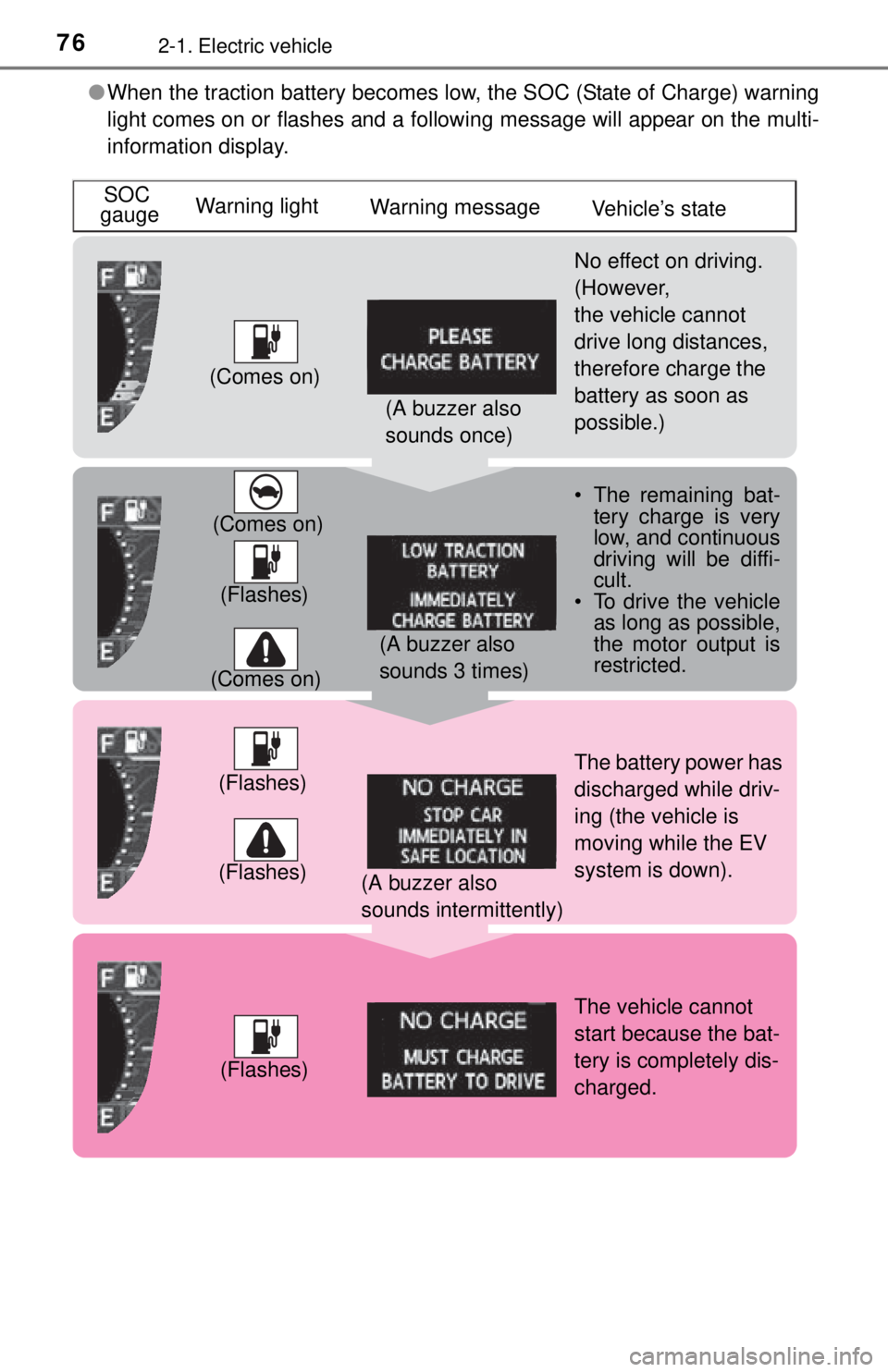
762-1. Electric vehicle
●When the traction battery becomes low, the SOC (State of Charge) warning
light comes on or flashes and a following message will appear on the multi-
information display.
SOC
gauge Warning light
Warning message
Vehicle’s state
No effect on driving.
(However,
the vehicle cannot
drive long distances,
therefore charge the
battery as soon as
possible.)
• The remaining bat- tery charge is very
low, and continuous
driving will be diffi-
cult.
• To drive the vehicle
as long as possible,
the motor output is
restricted.
The battery power has
discharged while driv-
ing (the vehicle is
moving while the EV
system is down).
The vehicle cannot
start because the bat-
tery is completely dis-
charged.
(Comes on)
(Comes on)
(Comes on)
(Flashes)(Flashes)
(Flashes)
(Flashes) (A buzzer also
sounds once)
(A buzzer also
sounds 3 times)
(A buzzer also
sounds intermittently)
Page 77 of 444
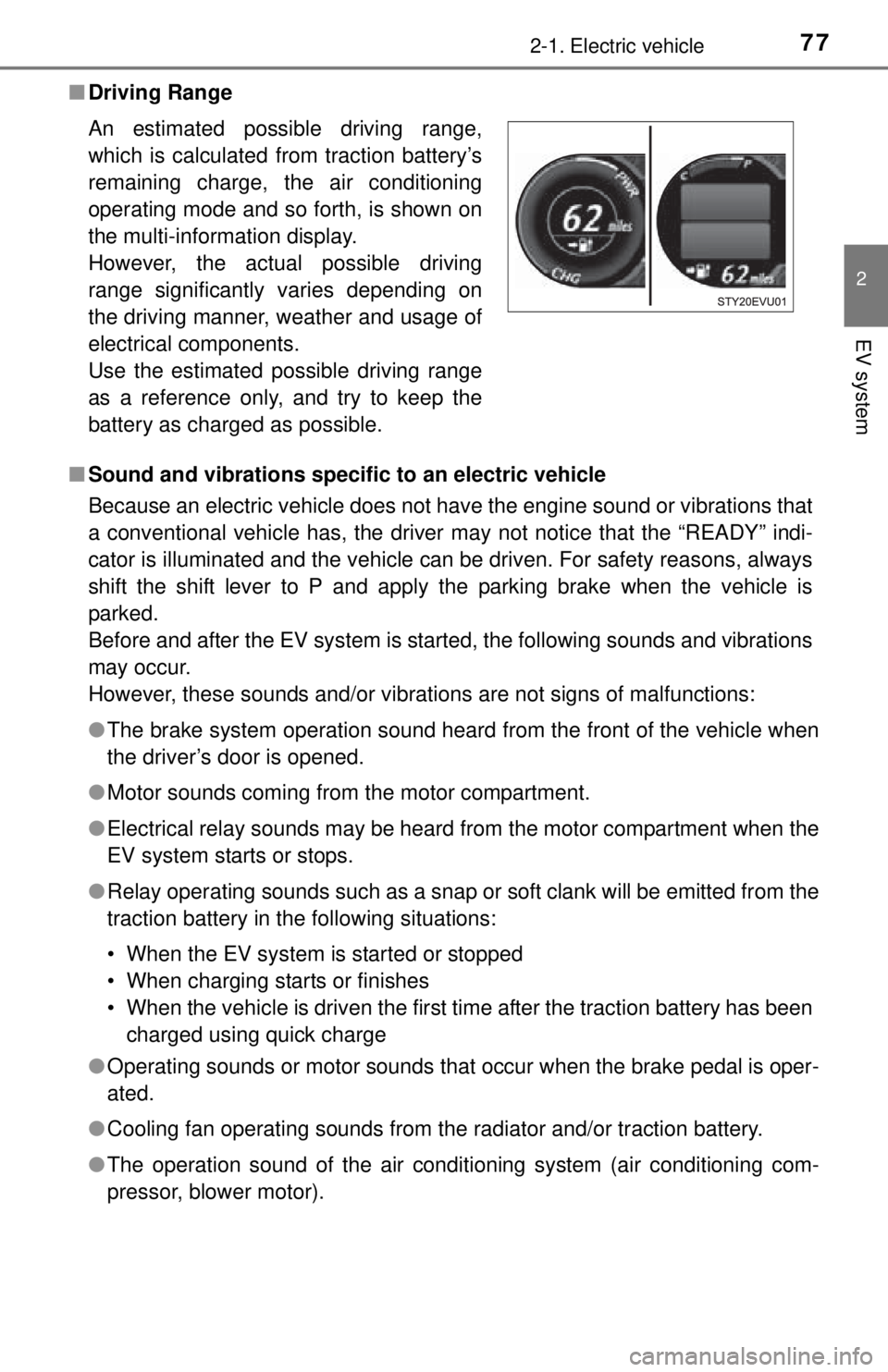
772-1. Electric vehicle
2
EV system
■Driving Range
■ Sound and vibrations speci fic to an electric vehicle
Because an electric vehicle does not have the engine sound or vibrations that
a conventional vehicle has, the driver may not notice that the “READY” indi-
cator is illuminated and the vehicle can be driven. For safety reasons, always
shift the shift lever to P and apply the parking brake when the vehicle is
parked.
Before and after the EV system is started, the following sounds and vibrations
may occur.
However, these sounds and/or vibrations are not signs of malfunctions:
● The brake system operation sound heard from the front of the vehicle when
the driver’s door is opened.
● Motor sounds coming from the motor compartment.
● Electrical relay sounds may be heard from the motor compartment when the
EV system starts or stops.
● Relay operating sounds such as a snap or soft clank will be emitted from the
traction battery in the following situations:
• When the EV system is started or stopped
• When charging starts or finishes
• When the vehicle is driven the first time after the traction battery has been
charged using quick charge
● Operating sounds or motor sounds that occur when the brake pedal is oper-
ated.
● Cooling fan operating sounds from the radiator and/or traction battery.
● The operation sound of the air conditioning system (air conditioning com-
pressor, blower motor).
An estimated possible driving range,
which is calculated from traction battery’s
remaining charge, the air conditioning
operating mode and so forth, is shown on
the multi-information display.
However, the actual possible driving
range significantly varies depending on
the driving manner, weather and usage of
electrical components.
Use the estimated possible driving range
as a reference only, and try to keep the
battery as charged as possible.